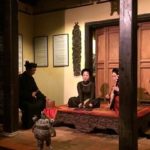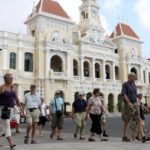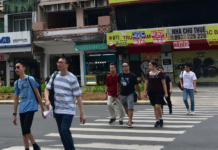For the first time, modern 3D mapping technology offers visitors to Hanoi a new perspective that cannot be experienced by visiting the monument during the day.
Visitors to the night tour “Quintessential Academic Traditions” at Temple of Literature, Hanoi. Photo: Huy Pham/The Hanoi Times
The recently launched night tour themed “Tinh Hoa Dao Hoc” or Quintessential Academic Traditions at the Temple of Literature has been heavily marketed by the Center for Scientific and Cultural Activities Van Mieu – Quoc Tu Giam in cooperation with Vietsoftpro Holdings.
A unique appeal of the capital’s tourism
This is the fourth night tour of Hanoi after the night tours of Hoa Lo Prison Relic Site, Thang Long Imperial Citadel, and Vietnam Literature Museum.
According to Associate Professor Dr. Dang Van Bai, Vice Chairman of the National Council for Cultural Heritage, after being launched in late October, the tours have created a highlight for the monument and offer new experiences to visitors.
“Thanks to modern digital technology, the Temple of Literature looks impressive. This is an effective model of cooperation between technology providers and cultural heritage managers, a typical example of public-private cooperation,” he said.
The Temple of Literature night tour is held every Wednesday, Saturday, and Sunday from 7 pm to 10 pm at a price of VND199,000 (US$8)/ticket. Admission is free for children under 1m tall.
Vibrant night at the Temple of Literature.
The night of “Heritage Convergence”
Guests of the night tour of the Temple of Literature, jointly run by the Center for Scientific and Cultural Activities Van Mieu – Quoc Tu Giam and the Hue Monuments Conservation Center, had the opportunity to experience the cultural atmosphere of the Nguyen dynasty with royal games, nha nhac or elegant music of the royal court, and court dances once reserved for the king, queen mother, and foreign envoys. The event was part of the “Heritage Convergence” art program to honor Vietnamese heritage.
An artistic light space was set up right at the entrance of Van Mieu. A tieu nhac, or a subgenre of the nha nhac ensemble, performed the medley “Thap Thu Lien Hoan” or Ten Continuous Concertos, while crowds of tourists snapped photos.
“This is the first time we’ve visited Van Mieu at night. It’s so sparkling,” said Tran Thi Hai Linh, a 30-year-old Hanoian who brought her son to the Temple of Literature.
Royal music of Hue at the Temple of Literature. Photo: Van Mieu – Quoc Tu Giam.
The event helped promote the heritage elements at night, reaffirming the goal of turning them into a typical tourism product of each locality and region.
In addition, artists from Hue had traveled to the current capital, bringing with them some Hue cultural specialties: Am Sinh Luyen Chu or “Mandarin’s Son Practice Writing – Millennial Culture” tableau, Tam Luan Cuu Chuyen (Three Turns and Nine Transformations) – Hue’s royal court song that opened important ceremonies under the Nguyen dynasty, Trinh Tuong Tap Khanh and Luc Cung Hoa Dang (Six Offerings) – two court dances often performed on the birthdays of the king, queen mother, queen and other nobles in the past.
The night tour offers a new perspective that visitors to the Temple of Literature cannot experience by visiting the monument during the day.
Nguyen Thi Thanh Tam, a 62-year-old Hanoian, said this was the first time she could listen to nha nhac and watch Hue court dances. “Tonight, the audience in the capital was treated like kings, queens, queen mothers, and high-ranking mandarins of the Nguyen dynasty. In the past, only the aristocracy was entitled to this art,” she said.
The Nguyen dynasty (1802-1945) was the last in Vietnamese history. It left great cultural legacies to the Vietnamese people, some of which have been recognized by UNESCO as World Heritage Sites: the Hue Monument Complex (1993), Hue Royal Music (2003), Nguyen Dynasty Woodblocks (2009), Nguyen Dynasty Imperial Archives (2014), and Hue Royal Architecture Literature (2016).
Located near the center of Vietnam, the ancient capital of Hue is also known as the “Divine Capital” or the “Land of Poetry.” It is one of the cities frequently mentioned in Vietnamese poetry and music for its romantic atmosphere and scenery. It is also the festival city of Vietnam, best known for Hue Festival – a biennial cultural event that attracts artists and tourists from around the world.
Ancient house in Ma May
NDO – Ma May, a rare quarter that still retains several old houses, has created one of the characteristics of Hanoi. Hanoi’s streets are becoming increasingly crowded and traditional features can sometimes be hidden behind modern life. But if one takes the time to relax and look around, the ancient features begin to reveal themselves.
Hanoi, HCM City see good growth of tourism revenue
NDO – In the first ten months of 2016, the revenue of Ho Chi Minh City’s tourism industry amounted to VND80 trillion while Hanoi’s reached over VND50 trillion.












